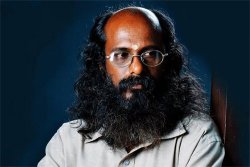
|   |

|   |
From the real to the realm of dream - Padma Jayaraj e-mail: padmajayaraj@gmail.com Photos courtesy: the artists October 23, 2014 It is a sheer coincidence that artists Sivadas Edakkattuvayal and Kalamandalam Bindulekha happened to exhibit their creativity that deal with the two fundamental yet conflicting aspects of human life, in the same venue. If stark reality is the inescapable fact of life, human beings cannot exist without the soul-nourishing dreams that make life livable and lovable. Their paintings in Durbar Hall, Kochi, Kerala (1st to 24th September) invited simple people to think of life’s enigma in simple pictorial idiom.  Sivadas Edakkattuvayal
Nirveshtitham by Sivadas showcased the theme of masks in life. Masks are ancient in their origin all over the world. They have been in use as playthings for children, for arts and crafts, and still is part of mystical religions handed down by ancient cultures. Curated as a liner narrative, the artist presents the story of the Mask through human history. Even today, children enjoy them as toys. Mask is part of ritual performances like the Teyyam, Thira, Padayani etc., in Kerala. Masks are used to scare the crows by farmers and to take away the evil eye by almost all. It is used to impersonate characters in dramas. All these are the positive features. However, Nirveshtitham, a Sanskrit word meaning the naked, points to a deeper attribute of the mask as seen in human relations highlighting its negative facet. The unseen mask that we wear today to hide our identity in personal, social and political life is the theme of the exhibition. The artist shares his angst with the viewers wondering whether a life without mask is possible today. The technique of contrasts powers his masquerade in human relationships. The painting of the couple with a thin veil of mask, against the background of two flowers and two birds, is replete with irony. Even in intimate relation, human beings, unlike other beings in nature cannot exist without the mask. This has become a universal phenomenon today where diplomacy is mistaken for duplicity, is the stern comment of the artist. Friendships are filtered through the mask. Interspersed with paintings of nature and other beings in their naked glory, the mask in human life acquires a sardonic shade. Yes, we heave a sigh of relief to find an assembly of humans in meditation where masks are absent. Face to face with the ultimate reality the mask falls off. Acrylic on canvas, the paintings in bright colours tinged with luminosity are pleasing to the eye as we traverse from hell to hope. The tonal quality has its aesthetical appeal, even when the theme is harsh reality. Trained as a sculptor from RLV College, Thripunithira, Kerala, Sivadas is doing his part as art-director for documentaries and short films. He is a fine human being committed to the cause of children. He is instrumental to an ongoing program with the concept of ‘one world for children’, wherein artists and humanists are roped in to chart the plans. View Slide show ‘The Voyage of Dreams’ by Kalamandalam Bindulekha in another hall is the display of the other side of the coin. Trained as a dancer in Kalamandalam, Bindulekha is a self-taught painter. Inspired by her mentor Sadanandan, a mural artist, she began in the traditional format. The exhibition showcases her oeuvre. The paintings of Krishna and Devi are representations of temple murals. Maybe prompted by an inner urge she deviated from tradition because of her passion for dance. The figurines in fluid forms poised in dance karanas became her unique signature. Then came a period of bold experiment. Her dreams took wings. Viewers are charmed by their own dreams as the artist gave forms to their intangible fancies. She has come out of the intricate style of the murals, both in figuration and composition.  Bindulekha
Thematically and stylistically she has a new approach. The paintings of the dragonflies dancing in the sky, the nymph of the deep sea, the swans poised as if in dance, are beauties that evoke an ethereal sense, far from the madding life. You just wonder whether they are the personifications of nature or the divine in themselves. In flowing lines, in subdued colours, Bindulekha transcends traditional murals to project the subliminal. Her dreamy figurines reminiscent of Ajantha paintings has continuity in the Indian art. The compositions implicate a decorative scheme offering a symbiosis of relationships between the beings in nature whether they are insects, birds or plants that foreground the figurative. There is range and diversity expressed through an individuated visual language close to rhythmic chant. The figurative idiom is linearly articulated in softly modulated colours. Without any pretentions to intellectual content her dancing figures, like insubstantial dreams, are joys forever. The latest, a face turned unto infinity, cast in shades of blue, within the halo of hair whereon translucent dragonflies flutter, evokes the presence of the sacred. Either male or female, an archetypal image of an iconic head, it stirs up the Buddha in the contemplative mood. Yet the distant look with a smile liltingly playing on the lips casts in a different light. Done for her husband’s venture, an art film, her painting connotes the theme and spirit of the movie. Bindulekha is a young artist and has a long way to go. Her uniqueness lies in projecting the subliminal, perhaps something exclusively feminine, hence the magic that lures. The exhibitions are remarkable for their aesthetics of communication, for the simplicity of visual language, and hence the simple audience that crowded the venue. Padma Jayaraj is a freelance writer on the arts and travel. She is a regular contributor to www.narthaki.com |